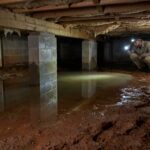Essential Guide to Foundation Repair: Protecting Your Home from Structural Damage
When it comes to homeownership, few things can send shivers down a homeowner’s spine quite like the thought of a foundation issue. You know, that eerie creak in the middle of the night? The one that makes you question if your house is auditioning for a horror movie? While your home may not be a haunted mansion, foundation problems can lead to some serious structural damage if left unchecked. But fear not! This essential guide will navigate you through the world of foundation repair, ensuring your home stays as sturdy as the day it was built.
Understanding Your Home’s Foundation
Before we dive into the nitty-gritty of repairs, let’s take a moment to understand what we’re dealing with. Your home’s foundation is its backbone, supporting the entire structure and ensuring everything remains upright (which is the goal, after all). There are different types of foundations—basement, crawl space, slab, and pier and beam, to name a few. Each one has its unique quirks and potential issues.
Basements are great for storage (or hiding from guests), but they can be prone to moisture problems. Slab foundations are popular in warmer climates but can crack due to shifting soil. Crawl spaces can lead to ventilation issues, while pier and beam foundations might become unstable if not properly maintained. Understanding your foundation type is key to identifying any issues that might arise.
Signs of Foundation Problems
Now that we know a bit about foundations, how do we determine if they’re in trouble? Keep an eye out for these warning signs:
1. **Cracks in Walls**: If you notice cracks appearing in your walls or ceilings, especially if they seem to be growing over time, it’s time to investigate further. Small hairline cracks can be normal, but wider cracks (greater than 1/4 inch) can indicate significant movement.
2. **Uneven Floors**: If your floors start feeling like a roller coaster ride—up on one side and down on another—it could be a sign that your foundation is settling unevenly.
3. **Doors and Windows Sticking**: If your doors and windows suddenly feel like they’re in a tug-of-war with the frame, this misalignment could be due to foundation movement.
4. **Separation from Walls**: Pay attention to gaps forming between walls and door frames, or worse, gaps between the ceiling and wall. These might look like they’re trying to make a break for it!
5. **Water Pooling**: If water seems to gather around your foundation instead of draining away, you likely have drainage issues that could lead to further foundation complications.
6. **Bowing Walls**: If you notice any walls bulging or bowing inward, it’s like your house is trying to do the limbo—a clear sign you should call for help.
If you see one or more of these signs, don’t panic; however, it’s crucial to act quickly before your home starts expressing itself through more dramatic structural changes.
Causes of Foundation Issues
The next step is understanding why these issues arise in the first place. Think of your foundation as a delicate ecosystem being influenced by external forces. Here are some common culprits behind foundation problems:
1. **Soil Type**: Believe it or not, the type of soil beneath your home plays a massive role in its stability. Clay-heavy soils can expand and contract with moisture changes, leading to shifting foundations. Sandy soils, on the other hand, may not retain enough moisture, leading to settling.
2. **Poor Drainage**: Water is both friend and foe. While your home needs it, excessive water pooling around your foundation can weaken it and lead to cracks. A proper drainage system is your foundation’s best buddy.
3. **Tree Roots**: Trees may look charming, providing shade and aesthetics, but their roots can creep in and disrupt your foundation. If you notice trees too close to your home, it may be time to reconsider their placement.
4. **Temperature Changes**: Extreme temperature fluctuations cause soil expansion and contraction, which can exert pressure on your foundation. It’s nature’s way of keeping us on our toes!
5. **Construction Quality**: Sometimes, the builder just didn’t get it right. Poor construction practices can lead to weak foundations that fail under pressure—kind of like a poorly made chair collapsing when someone sits on it.
Assessing the Damage: When to Call the Professionals
So, you’ve spotted some signs of potential foundation trouble. At what point do you need to call in the professionals? If you’ve noticed any of the signs mentioned earlier and they’re persisting or worsening, it’s advisable to seek expert assistance. A professional foundation repair contractor can assess the situation, often using specialized equipment to measure shifts and determine the underlying issues.
But before you pick up that phone, there are a few considerations to keep in mind:
– **Get Multiple Opinions**: Just like you wouldn’t go to a single restaurant for dinner without checking reviews, consider getting estimates from several contractors. This gives you a better idea of the scope of work involved and fair pricing.
– **Check Credentials**: Ensure that any contractor you consider is licensed, insured, and has references. Websites, testimonials, and reviews can provide insight into their reliability and quality of work.
– **Understand Your Options**: Various repair methods exist to stabilize and repair foundations, including underpinning, slabjacking, and piering. Understanding these options can help you make informed decisions.
Repair Methods: What to Expect
Ready to roll up your sleeves and tackle those foundation woes? There’s a good chance your contractor will use one of the following methods:
1. **Foundation Piers**: This method involves inserting piers deep into the ground to reach stable soil or bedrock. Think of them as the foundation’s super strong support beams.
2. **Slabjacking**: For homes with slab foundations, contractors will inject a mixture beneath the slab to lift it back to the desired level. It’s much like giving your home a little boost.
3. **Wall Anchors**: If walls are bowing or leaning, wall anchors are installed to pull them back into alignment. Imagine a superhero pulling the wall back into place!
4. **Hydrostatic Pressure Relief**: If water is a culprit, creating drain systems or sump pumps helps divert water and reduce hydrostatic pressure against the foundation.
5. **Grading and Drainage Solutions**: Improving grading around your home can redirect water away from the foundation and promote better drainage. It’s the equivalent of creating a moat around your castle—minus the sharks.
Maintenance Tips: Keeping Your Foundation Happy
Once repairs are completed, maintaining your foundation must become part of your home’s routine care. Here are some essential tips to keep everything in shipshape:
– **Monitor Moisture Levels**: Regularly inspect the area around your foundation for drainage issues. If water pools, address it promptly. Remember, water is your foundation’s best friend but also its worst enemy.
– **Manage Landscaping**: Avoid planting large trees or bushes too close to your home. Opt for plants with shallow root systems that won’t wiggle into your foundation’s business.
– **Inspect Your Gutters**: Ensure gutters are cleaned regularly and functioning correctly. Downspouts should direct water away from your foundation, ensuring it doesn’t turn into a swimming pool.
– **Look for New Cracks**: After repair, keep an eye on your walls and floors for any new cracks. Early detection can save you a lot of headache down the line.
– **Be Proactive**: Consider scheduling annual foundation inspections. A little precaution can help catch minor issues before they turn into major problems.
Conclusion
In conclusion, your home’s foundation is a crucial element that deserves your attention and care. By understanding the signs of foundation issues, their causes, and the solutions available, you can protect your home from structural damage and keep it standing strong. Remember, while cracks in the wall can bring a moment of panic, addressing issues proactively can save you from dire consequences later on.
So the next time you hear that mysterious noise at night, rest easy knowing that with the right knowledge, your home is more likely to be a sturdy fortress than a scene from a spooky thriller. Stay vigilant, and here’s to a solid foundation—both literally and figuratively!


